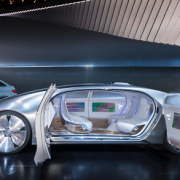News Roundup: Mass. State Senator Introduces Bill to Allow Zero-Emission Driverless Cars, Skipping Driverless Cars and Going Straight to Passenger Drones, and More
Jennifer van der Kleut
A roundup of headlines to come out of the driverless, connected-car industry in the past week:
Massachusetts Introduces Bill to Self-Driving Cars on Public Streets — As Long As They’re Electric
A new bill has been introduced at the state level in Massachusetts that would provide regulations for autonomous cars on public streets-as long as they’re electric. Senator Jason Lewis (D-Winchester) is preparing to file the bill with the State Senate, and says mandating that self-driving cars be zero-emission will help encourage automakers to be more environmentally friendly, which is line with Massachusetts’s priorities. Lewis said the bill would come with a tax of 2.5 cents per mile, to help offset lost state revenue from gas taxes. He said he welcomes ideas and suggestions and hopes the bill’s introduction will prompt “robust debate.” Read more from The Valley Dispatch.
Op-Ed: Forget Driverless Cars — The Future is Driverless Passenger Drones
Check out this opinion piece from Adam Singola. Singola argues almost suggests that simply making cars driverless is a waste of time, when we can take it one step further and make them flying, too. Singola said the future of transportation is flying passenger drones. He points out that one thing that makes human-driven cars so dangerous is the fact that they have to share the road with passengers, cyclists, unexpected objects and poor road quality, not to mention other cars. Therefore, he says driverless passenger drones will be safer, and will render things like parking problems, traffic congestion, and road construction obsolete. He also describes a ride he recently took in an actual passenger drone. Read more on TechCrunch.
U.S. Department of Transportation Identifies 10 ‘Proving Grounds’ for Testing Autonomous Vehicle Technology
In a move that many say will help the U.S. keep up with its Asian and European rivals, the U.S. Department of Transportation this week officially designated 10 sites across the country that officials say will act as “official sites for validating the technology,” as run by top organizations working on the technology. Automakers will be able to share the facilities to test their autonomous prototypes, and officials said they hope working in “close proximity” to others working on the same technology will allow them to share best practices and data. The 10 sites are run by the following organizations across the country: Thomas D. Larson Pennsylvania Transportation Institute; the Texas AV Proving Grounds Partnership; Maryland’s U.S. Army Aberdeen Test Center; California’s Contra Costa Transportation Authority (CCTA) and GoMentum Station in Concord, California; the San Diego Association of Governments in California; Michigan’s American Center for Mobility (ACM) at Willow Run; the Iowa City Area Development Group; the University of Wisconsin-Madison; Central Florida Automated Vehicle Partners; and the North Carolina Turnpike Authority. Read more from Bloomberg Technology.
Photo: Acura driverless car being tested at GoMentum Station in Concord, California.

